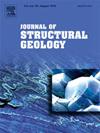断裂破坏带数值模拟及其对盐下碳酸盐岩储层构造演化的影响
IF 2.9
2区 地球科学
Q2 GEOSCIENCES, MULTIDISCIPLINARY
引用次数: 0
摘要
我们的工作采用数值模型来研究在类似盐下条件下,早期和晚期断层阶段对断层破坏带(DZs)发育的影响。与周围的寄主岩石相比,DZs在地质力学和岩石物理性质上表现出明显的差异。许多研究通过对断层形成过程的建模来探索DZs的特征。大多数巴西盐下储层都有与沉积构造发育相关的早期断层,这些断层被更深的晚期断层所覆盖。这两个断裂事件对现今的DZ宽度都有显著影响。前人的研究主要集中在早断陷阶段。然而,断裂晚期及其对DZs的影响尚未深入研究。因此,我们的目标是通过地质力学分析来研究早、晚断裂阶段对碳酸盐岩DZs构造演化的影响。研究结果表明,断裂晚期的埋藏作用增加了远离断裂带的封闭性,提高了岩石的完整性,而断裂早期形成的断裂带则保持不变。此外,在断层后期,我们采用摩擦系数来表示光滑或粗糙的表面,以评估断层粗糙度对DZ的作用。结果表明,粗糙的断层面有助于减小断层位移。本文章由计算机程序翻译,如有差异,请以英文原文为准。
Numerical simulation of fault damage zones and their impact on the structural evolution of Pre-salt carbonate reservoirs
Our work employs numerical models to investigate the impacts of the early and late faulting stages on the development of fault damage zones (DZs) in conditions analogous to Pre-salt. DZs exhibit contrasts in geomechanical and petrophysical properties compared to the surrounding host rock. Numerous studies have explored the characterization of DZs by modeling fault formation processes. Most Brazilian Pre-salt reservoirs have early faults associated with depositional tectonic development overprinted by late faults that formed at greater depths. Both faulting events can markedly affect the present-day DZ widths. Previous studies have investigated the development of DZ during the early faulting stage. However, the late faulting stage and its impact on DZs have not been explored. Thus, our goal is to investigate the impact of both the early and late faulting stages in the structural evolution of DZs in carbonate rocks through geomechanical analyses. The results indicate that burial during the late faulting stage increases confinement and enhances the integrity of the rock far from the DZ, while the DZs triggered during the early fault formation remains unchanged. In addition, for the late faulting stage, we assess the role of fault roughness on the DZ by adopting friction coefficients to represent smooth or rough surfaces. The results show that rough fault surfaces contribute to lower fault displacements.
求助全文
通过发布文献求助,成功后即可免费获取论文全文。
去求助
来源期刊

Journal of Structural Geology
地学-地球科学综合
CiteScore
6.00
自引率
19.40%
发文量
192
审稿时长
15.7 weeks
期刊介绍:
The Journal of Structural Geology publishes process-oriented investigations about structural geology using appropriate combinations of analog and digital field data, seismic reflection data, satellite-derived data, geometric analysis, kinematic analysis, laboratory experiments, computer visualizations, and analogue or numerical modelling on all scales. Contributions are encouraged to draw perspectives from rheology, rock mechanics, geophysics,metamorphism, sedimentology, petroleum geology, economic geology, geodynamics, planetary geology, tectonics and neotectonics to provide a more powerful understanding of deformation processes and systems. Given the visual nature of the discipline, supplementary materials that portray the data and analysis in 3-D or quasi 3-D manners, including the use of videos, and/or graphical abstracts can significantly strengthen the impact of contributions.
 求助内容:
求助内容: 应助结果提醒方式:
应助结果提醒方式:


